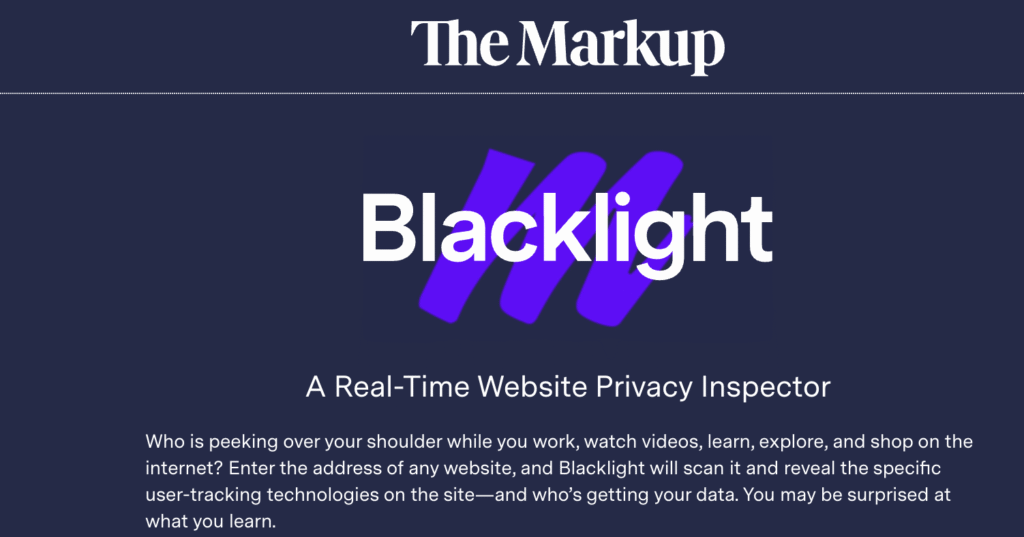A free tool that gives a broad 300 foot high view of privacy trackers on a website is called Blacklight. An early stage tool that was created to empower users and privacy professionals to uncover hidden tracking mechanisms. Blacklight, a free, real-time website privacy inspector developed by The Markup, a nonprofit journalism organization dedicated to investigating technology’s impact on society. Launched in September 2020, Blacklight was once the go-to resource for detecting invasive trackers on websites, helping privacy advocates, lawyers, and compliance officers shine a light on data collection practices that often operate in the shadows. While it’s not super comprehensive in detailing the type of cookies & trackers and uses some scary words that are not always accurate such as key loggers it’s a good free tool to start a privacy research project off with.
RUN A FREE COOKIE SCAN NOW AND COMPARE THE DETAILED RESULTS
What Is Blacklight and Why Does It Matter?
Blacklight is an online tool accessible at blacklight.themarkup.org, designed to scan any website for user-tracking technologies. Its primary purpose is to reveal how sites monitor visitors without their explicit knowledge or consent, exposing practices like ad tracking, fingerprinting, and session recording. By democratizing access to this information, Blacklight empowers individuals and organizations to make informed decisions about online privacy and pushes for greater transparency from web operators.

For privacy professionals and lawyers, Blacklight serves as a practical instrument in audits, investigations, and litigation. It has been instrumental in high-profile exposes, such as revealing trackers on COVID-19 vaccine websites, which spurred legislative scrutiny and reforms.
With over 10 million scans conducted by users worldwide, the tool underscores the pervasive nature of online surveillance and aids in building cases under laws like the California Invasion of Privacy Act (CIPA) or the Electronic Communications Privacy Act (ECPA), where unauthorized data interception is at issue.
How Blacklight Works: A Technical Overview
Using Blacklight is straightforward: Enter a website URL into the tool, and it performs an automated inspection in real-time. Behind the scenes, Blacklight employs a headless browser to simulate a user visit, analyzing network requests, JavaScript code, and page behavior to identify tracking scripts.
Key detection methods include:
- Ad Trackers and Third-Party Cookies: Identifies scripts from companies like Google, Facebook, or Amazon that set cookies for cross-site tracking.
- Canvas Fingerprinting: Detects attempts to create unique device identifiers by rendering invisible graphics and hashing the output.
- Keyloggers and Session Replay: Spots code that records keystrokes, mouse movements, or full user sessions for replay.
- Other Trackers: Scans for pixels, beacons, and analytics tools that transmit data to third parties.
The tool draws from databases like DuckDuckGo’s Tracker Radar for classifying domains, ensuring detections are based on up-to-date intelligence.
Results are presented in a clear report, categorizing findings by severity and providing details on data recipients. However, limitations exist: Blacklight may miss sophisticated trackers, produce false positives, or overlook server-side tracking. It primarily scans from a U.S. IP address, though an EU option was added for regional compliance checks.
Key Features and User Enhancements
Blacklight’s features make it accessible yet powerful:
- Real-Time Scanning: Instant results without needing software installation.
- Detailed Reports: Breaks down trackers by type, with links to methodologies for transparency.
- Open-Source Elements: Parts of the code are available on GitHub (e.g., blacklight-collector), encouraging community contributions.
- Options for Customization: Users can now scan from EU locations and override caching for fresh results.
These elements position Blacklight as more than a scanner—it’s an educational resource, helping users understand privacy risks in tangible terms.
Recent Updates and Evolutions
As of mid-2025, Blacklight continues to evolve based on user feedback and emerging threats. A notable update in March 2024 integrated an enhanced version of DuckDuckGo’s Tracker Radar, improving detection accuracy for third-party domains. Additionally, a cache override feature was introduced, allowing users to force fresh scans instead of relying on 24-48 hour cached results—ideal for developers testing privacy fixes.
No major 2025 updates have been announced yet, but The Markup encourages feedback via blacklight@themarkup.org for future enhancements.
The tool’s methodology is periodically refined, such as tweaks to Google Analytics detection, to keep pace with tracker evolutions.
Implications for Privacy Professionals and Lawyers
For those in privacy law and compliance, Blacklight is a Swiss Army knife. It can support:
- Audits and Compliance: Verify if websites honor opt-outs under CCPA or GDPR, identifying discrepancies that could lead to violations.
- Litigation Support: Generate evidence of unauthorized tracking, as seen in CIPA suits where tools like Blacklight help demonstrate “interception” of user data.
- Advocacy and Education: Use scan results in reports or trainings to highlight risks, fostering better data protection practices.
In cases like the Motorola privacy suit, where opt-out failures allowed third-party tracking, Blacklight could have been used to detect such issues proactively. Its findings align with ECPA concerns over electronic communications interception and CCPA’s opt-out mandates, making it a bridge between technical analysis and legal arguments.
Broader Impact and Takeaways
Blacklight has not only amassed millions of scans but also influenced policy, with its data cited in congressional hearings and privacy bills. As digital tracking grows more insidious, tools like this remind us that visibility is the first step to accountability.
Privacy practitioners should integrate Blacklight into their toolkits: Run regular scans on client sites, document findings for DPIAs, and stay tuned for updates. In a world of “dark patterns” and hidden scripts, Blacklight ensures the light stays on.